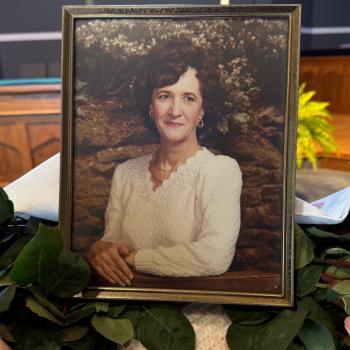In this moment heavy with concern and confusion, this beloved disciple leans closer to Jesus and lays his head on his rabbi's chest. The original language indicates much more strongly that this beloved one "was reclining . . . in the bosom of Jesus" (Jn. 13:23). There he rests in Jesus' easy embrace. It is a place of acceptance and safety, a place of supreme trust and unashamed devotion.
This vignette offers us a breathtaking reality: Jesus welcomes our affectionate devotion. In our mind, our heart, our innermost being, we too can rest against the bosom of our Lord and he will not push us away. Like the beloved disciple, we can experience a relationship of love and trust, now and forever.
This was the love Jesus lived with his disciples, as revealed within the pages and between the lines of the gospels: It was honest, clear, passionate, without shame or restraint. Jesus expressed a wide range of emotions with his followers—even anger—but love was the foundation of them all.
2) Jesus expressed anger in straightforward ways—in the service of God's justice.
We are surrounded by anger in our divisive society, and much of it is unhealthy, harmful, and counterproductive. But there's a category of anger that we must also recognize: righteous anger, the kind of anger Jesus displays. Righteous anger can give us courage to do what we might otherwise not be able to do, helping us to overcome the paralysis of fear. It can fuel outspokenness to rebuke evil or injustice, giving force to reproaches that otherwise we'd keep to ourselves or simply mumble in complaint. We can see this sort of anger today, for example, in the call for gun control in response to recent horrific shooting rampages.
In one incident recorded in all four gospels, Jesus puts his fury into action. Jesus comes to Jerusalem to celebrate the Passover, and what he finds in the temple makes his blood boil (Jn. 2:14-17). The religious establishment was profiting from the law of God, forcing the people to purchase "unblemished" sacrificial animals at grossly inflated rates, and compelling them to pay to exchange their money for "acceptable" coins. What God had established as a means to enter into the divine presence in worship had been corrupted into a tawdry moneymaking enterprise. When Jesus saw what was happening, he responded in whip-cracking fury with tables and coins flying, animals and temple leaders scrambling.
Jesus is revealed as a person who feels his anger deeply and unambiguously. You know where he stands. His actions show us that what we believe and how we act matters to God. It reveals what's wrong. It fights against injustice and oppression. It causes change. It makes noise. And it may even get us into trouble.
3) Jesus felt his fear, allowing it to energize and empower his resolve.
Jesus experiences a climax of fear in an olive garden called Gethsemane. As he and his disciples gather on this dark night, Mark's account (14:32-42) says he takes Peter, James, and John with him a little farther to a place in the garden where he could pray. Jesus "began to be distressed and agitated. And he said to them, 'I am deeply grieved, even to death; remain here, and keep awake.'" In another translation Jesus says, "My soul is overwhelmed with sorrow to the point of death." He went further into the garden and "threw himself on the ground and prayed that, if it were possible, the hour might pass from him." He acknowledges that with God "all things are possible" and pleads for God to "remove this cup from me"—the cup of suffering and death. And yet, "not what I want, but what you want." Jesus is willing to let go of his fear, his terror over the betrayal, suffering, and death that await him, for the greater glory of the will of God.
Perhaps this act of surrender to his purpose calms his troubled soul. Jesus has wrestled with his terror—the ultimate matters of torture and brutal death—and surrenders to God's will. As a fully human being he has embraced his feelings, acknowledged them, prayed over them, and turned them over to God. He confronts his deepest fears, his ambivalence about what is to happen, so that, out of his deep anguish, he can say "yes" to God: "Your will be done."
4) Jesus fully felt his grief and so is able to offer true hope.
When Jesus joins his friends Mary and Martha at the tomb of their beloved brother Lazarus in John 11, we witness the unrestrained weeping of a broken heart. Some commentators assume Jesus would not grieve because he knew he was able to restore Lazarus to life, but it cannot be clearer that Jesus experiences a rush of grief so deep that he bursts into tears. Here, together with sorrowful family and friends outside the tomb, Jesus enters into and embraces the grief of those around him. His fury at death is strangled and overwhelmed by his sorrow over death's catastrophic impact on the human family.




